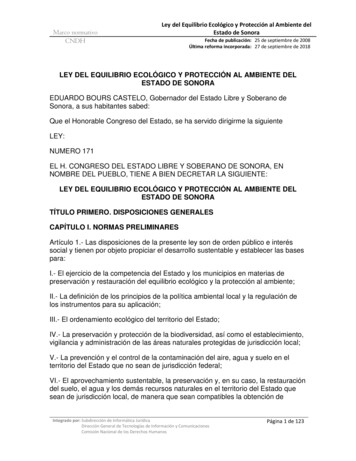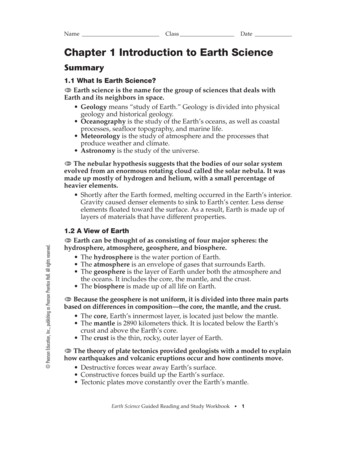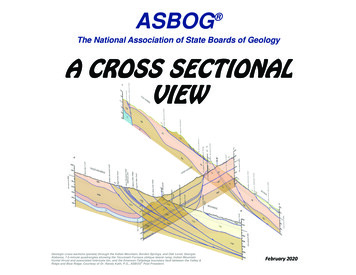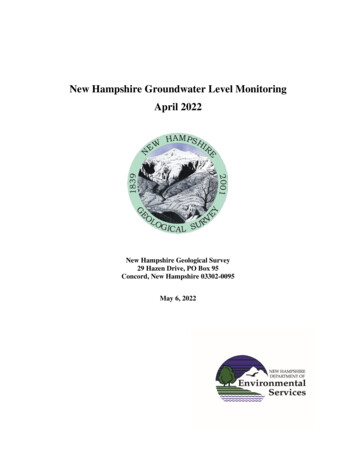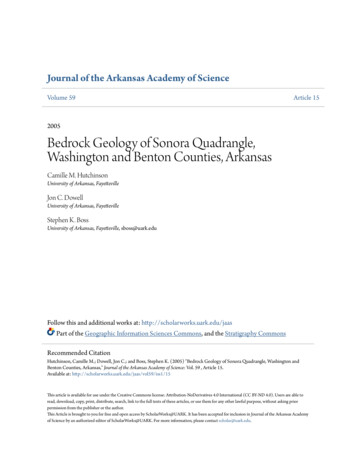
Transcription
Journal of the Arkansas Academy of ScienceVolume 59Article 152005Bedrock Geology of Sonora Quadrangle,Washington and Benton Counties, ArkansasCamille M. HutchinsonUniversity of Arkansas, FayettevilleJon C. DowellUniversity of Arkansas, FayettevilleStephen K. BossUniversity of Arkansas, Fayetteville, sboss@uark.eduFollow this and additional works at: http://scholarworks.uark.edu/jaasPart of the Geographic Information Sciences Commons, and the Stratigraphy CommonsRecommended CitationHutchinson, Camille M.; Dowell, Jon C.; and Boss, Stephen K. (2005) "Bedrock Geology of Sonora Quadrangle, Washington andBenton Counties, Arkansas," Journal of the Arkansas Academy of Science: Vol. 59 , Article 15.Available at: s article is available for use under the Creative Commons license: Attribution-NoDerivatives 4.0 International (CC BY-ND 4.0). Users are able toread, download, copy, print, distribute, search, link to the full texts of these articles, or use them for any other lawful purpose, without asking priorpermission from the publisher or the author.This Article is brought to you for free and open access by ScholarWorks@UARK. It has been accepted for inclusion in Journal of the Arkansas Academyof Science by an authorized editor of ScholarWorks@UARK. For more information, please contact scholar@uark.edu.
Journal of the Arkansas Academy of Science, Vol. 59 [2005], Art. 15Bedrock Geology of Sonora Quadrangle,Washington and Benton Counties, ArkansasCAMILLEM. HUTCHINSONJON C. DOWELL, AND STEPHEN K.BOSS*of Geosciences, 113 Ozark Hall, University ofArkansas,DepartmentFayetteville, AR 72701Correspondent: sboss@uark.eduAbstractA digital geologic map of Sonora quadrangle was produced at 1:24,000 scale using the geographic information systemGIS) software Maplnfo. The geology of Sonora quadrangle consists of sedimentary rocks from the Ordovician, Devonian,Mississippian, and Pennsylvanian Systems. The Cotter, Powell, and Everton formations represent the Ordovician System. TheClifty and Chattanooga formations represent the Devonian System. The St. Joe Limestone, Boone, Batesville, and Fayettevilleformations represent the Mississippian System. The Hale formation represents the Pennsylvanian System. The St. JoeLimestone crops out extensively in Sonora quadrangle and is unconformably overlain by the Boone formation in the southernportion of the quadrangle. This unconformity adds credence to the suggestion that the St. Joe Limestone should be elevated toformation status rather than remain as a member of the Boone formation. The Fayetteville formation consists of the informallynamed lower Fayetteville Shale, Wedington Sandstone, and informally named upper Fayetteville Shale. The only member ofthe Hale formation observed in Sonora quadrangle was the Cane Hill member. The two prominent geologic structures inSonora quadrangle are the White River fault running generally east-west and the Fayetteville fault running generally southwestnortheast. Other subsidiary faults are associated with these primary faults, creating fault zones within the quadrangle. Detailedmapping of stratigraphy and structure in Sonora quadrangle provides new insights into the geologic evolution and sea-levelhistory of the Ozark Plateaus and the southern craton margin during the Paleozoic EraIntroductionThe Paleozoic geology of the southern Ozark region hasattracted worldwide interest because of exposures of theMorrowan Series at the base of the Pennsylvanian Systemand for the excellent outcrops of fossiliferous strata iniroximity to the Mississippian-Pennsylvanian boundaryFrezon and Glick, 1959; Manger and Sutherland, 1984;VIcFarland, 1998). The geologic history and depositionaldynamics of this Paleozoic interval continues to attracthe attention of the geologic community as a meansof investigating the interplay of global tectonics and globaleustasy in the development of continental margin andbreland basin sequences (Houseknecht, 1986; Viele, 1989;Ethington et al., 1989; Thomas, 1989; Viele and Thomas,1989; Handford and Manger, 1990, 1993; Valek, 1999;Hudson, 2000; Anderson, 2001; Combs, 2001; Cooper,2001). However, despite continued interest in the Paleozoicstratigraphy of northern Arkansas, no detailed mapping ofthe geology of Sonora quadrangle has occurred since thesiswork undertaken in the early 1960's (Metts, 1961; Cate,1962; Carr, 1963; Clardy, 1964) at the University ofArkansas and since preparation of the revised GeologicMap of Arkansas by Haley et al. (1976 and 1993).With the advent of satellite positioning services,advanced digital technologies, and geographic informationsystems during the last decade, itis now possible to develophighly detailed geologic maps from field data with locationsFig. 1. A) Location map of Arkansas showing Washingtonand Benton Counties (shaded) and B) Sonora quadrangle inWashington and Benton Counties.determined using the global positioning system (GPS) anctransferred to digital mapping programs. Development ogeologic maps in digital formats permits relatively easymanipulation of these data and their export to a variety osoftware platforms where they can be modified or adaptecfor many projects. This project represents the first effort tomap individual stratigraphic members inSonora quadrangleusing digital technologies.Journal of the Arkansas Academy of Science, Vol. 59, 2005Published by Arkansas Academy of Science, 2005101101
Journal of the Arkansas Academy of Science, Vol. 59 [2005], Art. 15Camillc M. Hutchinson,Jon C. Dowell, and Stephen K.BossSonora quadrangle (Fig.1) is located in northeast WashingtonCounty and southeast Benton County, Arkansas, and isnamed for the community of Sonora, which occupies thecentral portion of the quadrangle (Fig. 1). The quadrangleboundaries are 36 15.0'N 94 07.5'W (northwest), 36 07.5'N94 07.5.0'W (southwest), 36 15.0'N 94 0().0'W (northeast),and 36 07.5'N 94 ()0.0'W (southeast). The landscape is amaturely dissected, dendritic drainage system dominated bythe White River, which flows north through the quadrangleand into Beaver Lake (Figs. 3, 4). Whereas upland areasthroughout the quadrangle are heavily forested, excellentexposures of all lithostratigraphic units through the Haleformation can be observed in ravines associated with BeaverLake, the White River and its tributaries, roadcuts alonghighways U.S. 412 and AR 265, and in on-going excavationsproduced by construction activities in the region.Washington and Benton counties occupy the boundary oftwo erosional plateaus formed along the southern portion ofthe Ozark Dome (Croneis, 1930). The Springfield Plateau iscomposed of strata deposited during the Ordovician(490-443 Ma BP; Palmer and Geissman, 1999) throughMississippian (354-323 Ma BP; Palmer and Geissman, 1999)periods. The higher Boston Mountains Plateau in the extremesouthern portion of Sonora quadrangle is formed of lateMississippian through middle Pennsylvanian strata and iscapped by the Pennsylvanian -aged Cane Hillmember of theHale formation (Fig. 2; Stan ton, 1993).The topography of the quadrangle is controlled by anumber of stratigraphic units. The Wedington member of theFayetteville formation is often expressed as an elevated benchon hillsides and caps some hills in the western portion ofthe quadrangle. Prominent bluffs around the lake and river(ranging to 30 meters high) in Sonora quadrangle are alsoassociated with outcrops of the Everton formation, St. Joe Fig. 2. Generalized stratigraphic column of SonoraLimestone, and the Boone formation. Finally, sandstone units quadrangle, Washington and Benton Counties, Arkansasof the Hale formation form bluffs and cap some hilltops in the (adapted from Stanton, 1993).southern portion of Sonora quadrangle.Materials and Methodsoutcrop or sample location, GPS coordinates were noted inthe field notebook, and the location was indicated on the fieldField mapping of Sonora quadrangle was conductedmap. A Garmin Etrex was used to determine elevations. Thethroughout the summer of 2003 accessing various locations locations gathered were recorded onto a 1:24,000 topographicfrom a network of county and state roadways or on foot and map in the field and logged into the field book for laterfrom boat around the shoreline of Beaver Lake. Commonly, transfer to the Maplnfo digital mapping program.rock fragments and soil type could be used to determine theA geographic information system (GIS) is a computebedrock stratigraphy in areas of low relief where outcrops system that records, stores, and analyzes geospatiawere not discernable.information. Information regarding field geologic relationLocations of outcrop sites for individual stratigraphicwas transferred from the field map to a digital raster graphimembers and observed geologic structures were determined (DRG) of Sonora quadrangle using a "heads-up" digitizinusing global positioning system (GPS) receivers capable of method that was described in detail inJ.T. King et al. (2002receiving differential corrections. These receivers typically Sullivan and Boss (2002), M.E. King et al. (2001a and b)have horizontal accuracy of approximately 3 meters. For each Using this method, stratigraphic units and geologic structure(e.g. faults) were drawn directly on the computer screen bJournal of the Arkansas Academy of Science, Vol. 59, 5102102
Journal of the Arkansas Academy of Science, Vol. 59 [2005], Art. 15Bedrock Geology of Sonora Quadrangle, Washington and Benton Counties, ArkansasFig. 3. Map showing bedrock geology of the northern half of Sonora quadrangle digitizeddigital raster graphic (DRG).Fig. 4. Map showing bedrock geology of the southern half of Sonora quadrangle digitizeddigital raster graphic (DRG).Sonora quadrangle 7.5-minuteontoontoSonora quadrangle 7.5-minuteJournal of the Arkansas Academy of Science, Vol. 59, 2005Published by Arkansas Academy of Science, 2005103103
-Journal of the Arkansas Academy of Science, Vol. 59 [2005], Art. 15Camille M. Hutchinson, Jon C. Dowell, and Stephen K.Bossmoving the cursor over a DRG of Sonora quadrangle andclicking the mouse button at short intervals to trace contactsonto the displayed topography. Each stratigraphic unit orstructural feature was digitized as a separate layer within theGIS such that the display of each layer could be toggled onor off. Once all stratigraphic units and geologic structureswere digitized, map layers could be displayed hierarchicallyto generate the geologic map of the study area (Figs. 3, 4, 5).The final step in preparing the digital geologic map was toconvert all data layers to several digital formats to ensurecompatibility with popular GIS applications. Alldata werearchived on CD-ROM and are available from thecorresponding author upon request.light gray to brownish gray and are generally more or le sdolomitic and sandy. The dolostones are light- to dark-gn /and generally more or less limy and sandy. The Kings Riv rSandstone is the only representative of the Everto iformation within Sonora quadrangle. This member scomposed of massive to thinly parallel layers of friabli ,quartz sandstone. In Sonora quadrangle, the Everto iformation varies in thickness from 2 to nearly 12 m.Itis be. 1exposed at the Hickory Creek Recreation Area, along th lakeshore east of Hickory Creek Recreation Area, andaround the Pleasant Heights development (Figs. 6A, B). Inthese areas, the Everton formation forms resistant bluffs andwas observed to be filling sinkholes in the underlying Poweliand Cotter formations. Exposed cross-sections of Evertonformation bluffs also reveals paleochannels (Fig. 6A).Devonian strata present in Sonora quadrangle are(in ascending order) the Clifty formation and ChattanoogaShale (Figs. 3, 4, 5). The Clifty formation restsunconformably on the Everton formation, and excellentexposures of this contact were documented in the vicinity ofthe Hickory Creek Recreation Area (Fig. 6B). The Cliftyformation is often confused with the Sylamore Sandstonemember of the Chattanooga Shale (Metts, 1961). However,it is distinguishable from the Sylamore Sandstone in thatfresh surfaces are white, saccharoidal quartz sand, whereasfresh surfaces of the Sylamore Sandstone are typicallyyellow to yellowish brown containing phosphatic pebblesand limonitic concretions (Hall, 1978). McFarland (1998)suggested that the maximum thickness of the Cliftyformation was approximately 1 m. However, in Sonoraquadrangle, the Clifty formation appears to reach maximumthickness in the Hickory Creek area of 3-4 m.The Chattanooga formation is a black, fissile, clay shalethat weathers into thin flakes. The beds are usually cut byprominent joints creating polygonal blocks uponweathering. In Sonora quadrangle, the basal sandstonemember (Sylamore Sandstone; Branner, 1891) of theChattanooga Shale was not observed. The thickness ofthe Chattanooga Shale ranged from 3 to approximately1ResultsSedimentary rocks of the Ordovician Period (490443 Ma BP; Palmer and Geissman, 1999) throughPennsylvanian Period (323-290 Ma BP; Palmer andGeissman, 1999) are present throughout Sonora quadrangle.Rocks of the Ordovician Period (in ascending order) are theCotter formation, the Powell formation, and the Kings Rivermember of the Everton formation. Ordovician strata aregenerally present only along the shoreline of Beaver Lake inthe northern portion of the quadrangle (north of the WarEagle Marina and Recreation Area) and on the bottom ofthe lake along the main axis of the former channel of theWhite River (Figs. 3, 4).The Cotter formation in Sonora quadrangle is mostlyinundated by Beaver Lake, though exposures of the top ofthe Cotter formation can be observed when lake level is loweast of the Hickory Creek Recreation Area (Fig. 3). Whenexposed, the Cotter weathers to cobbles of dark gray,blocky chert.The Powell formation is also poorly exposed in Sonoraquadrangle. Outcrops of the Powell formation wereobserved lying unconformably on the Cotter formationalong the northern lakeshore east of the Hickory CreekRecreation Area (Fig. 3). The Powell formation is generallya fine-grained, light-gray to greenish-gray, limy, argillaceousdolostone with thin beds of light green shale (Purdue andMiser, 1916). The Powell formation reaches 65 m (215 feet)thick in its type area. However, within Sonora quadrangle,observed exposures of the Powell formation are less than 3meters. The top of the Powell formation is unconformablewith the overlying Everton formation.The Everton formation was named for Everton,Arkansas, in Boone County (Purdue, 1907). The Evertonformation shows considerable differences in lithologiccharacter across the Ozark region (Suhm, 1970; 1974). Itiscomposed of various mixtures of dolostone, sandstone, andlimestone. The formation also has some conglomeraticfacies, shale, and chert in limited areas. The limestones are9 m.An important discovery of this mapping project wasdocumentation of a very fine -to fine-grained, siltysandstone capping the Chattanooga Shale north andnorthwest of Friendship Creek (Figs. 6C, D). This unnamedsandstone occurred as several layers, each of which wasapproximately 0.3-0.6 m, and separated the ChattanoogaShale from the overlying Bachelor member of the St. Joeformation (Fig. 6D). In addition, a channel incised into theChattanooga Shale and backfilled with this sandstone wasobserved at one location. Elsewhere throughout thequadrangle, this sandstone was not observed, and theBachelor member lies directly on the Chattanooga Shale. Itis not known ifthis sandstone represents a basal sand unit ofJournal of the Arkansas Academy of Science, Vol. 59, 5104104
Journal of the Arkansas Academy of Science, Vol. 59 [2005], Art. 15Bedrock Geology of Sonora Quadrangle, Washington and Benton Counties, ArkansasFig. 5. Legendto accompanygeologic map of Sonora quadrangle (Figs. 3,4).Journal of the Arkansas Academy of Science, Vol. 59, 2005Published by Arkansas Academy of Science, 2005105105
Journal of the Arkansas Academy of Science, Vol. 59 [2005], Art. 15Camille M. Hutchinson, Jon C. Dowell, and Stephen K.Bossthe Bachelor member. However, its association as thesediment filling a channel incised into the ChattanoogaShale demonstrates the unconformable nature of its contactof Fayetteville (Simonds, 1891). The Fayetteville Shale isblack to dark gray, organic-rich, and calcareous in places(McFarland, 1998). It locally contains abundant septarianconcretions ranging from a few cm to almost a m indiameter, some of which contain hydrocarbons and sideritecement (Hutchinson, 2001). The Fayetteville Shale issubdivided into two informally named stratigraphic unitsand one formal member: lower Fayetteville Shale(informal), the Wedington Sandstone (formal), and theupper Fayetteville Shale (informal). The lower FayettevilleShale is black, fissile shale. The base is exposed in Sonoraquadrangle at the base of Fitzgerald, Webber, and PriceMountains (Fig. 3). The lower Fayetteville Shale outcropsoccur widely throughout the southern half of Sonoraquadrangle (Fig. 4). The shale often weathers to expansiveclay, resulting in damage to foundations of structures builton this shale (King et al., 2001b). The Wedington Sandstonemember of the Fayetteville Shale is tan to gray, wellindurated, very fine-to medium-grained sandstone with anaverage thickness of 2 m. The thickest observed outcrop ofWedington Sandstone (approximately 10 m) is located onthe top of Webber Mountain, southeast of the town ofSpringdale (Figs. 3, 4). The upper Fayetteville Shale is ablack, fissile shale that contains abundant iron concretions( 0.2 m diameter). This informally named member of theFayetteville Shale is much thinner than the lowerFayetteville Shale. The upper Fayetteville Shale weathersquickly to expansive clay and is rarely observed in outcrop.The upper Fayetteville Shale can be seen in thesouthwestern area of the quadrangle along Zion Road eastof Arkansas Highway 265 (Fig. 4). In Sonora quadrangle,the top of the Fayetteville formation is an erosion surfacewith minor relief overlain unconformably by the CaneHill member of the Hale formation (McFarland, 1998).contactThis unconformablealso representstheMississippian-Pennsylvanianboundary (Handford andManger, 1990, 1993).The only Pennsylvanian stratum in Sonora quadrangleis the Cane Hillmember of the Hale formation. The Haleformation was named for Hale Mountain in the vicinity ofWashington County, Arkansas (Adams and Ulrich, 1905).The Cane Hillmember is comprised of several lithologiccomponents: a basal tan, very thin-bedded, mediumgrained, siliceous/calcareoussandstone or calcareousconglomerate, alternating with very thin-bedded ( 0.15 mthick) siltstone and sandstone layers, often ripple-marked,and thick, tan, ripple-marked, medium grained, siliceoussandstone (Adams and Ulrich, 1905; Henbest, 1953; Cate,1962; Handford and Manger, 1990, 1993; M.E. King et al.,2001a and b).Structural Geology. -Sonora quadrangle is situated onthe southern flank of the Ozark Dome that is centeredin southeast Missouri (Croneis, 1930). The regional dip ofon the shale.The Mississippian strata in Sonora quadrangle are (inascending order) the St. Joe formation, the Boone formation,the Batesville formation, and the Fayetteville formation.Rocks of the Mississippian Period comprise the largestsurface exposures throughout the quadrangle (Figs. 3, 4, 5).The St. Joe formation is the oldest Mississippianstratum. The formation is named for exposures near St. Joe,Arkansas in Searcy County (Hopkins, 1893). The formationis a fine-grained, crinoidal limestone that may occasionallycontain some dark gray nodular chert (McFarland, 1998).The base of the St. Joe formation is a greenish-gray shale,the Bachelor member (Manger and Shanks, 1977). The St.Joe formation occurs throughout Sonora Quadrangle withthe best exposures around Beaver Lake. Along the WhiteRiver in the southern portion of the quadrangle, the top ofthe St. Joe formation is exposed and is overlainunconformably by the Boone formation (Figs. 6E, F). Booneformation layers were observed to downlap onto the top ofthe St. Joe formation in some areas (Fig. 6E). In others,broad shallow channels in the top of the St. Joe formationwere filled with prograding clinoforms at the base of theBoone formation (Fig. 6F), and lowermost Boone formationlayers contained limestone and chert clasts that appeared tobe reworked from the underlying St. Joe formation.The Boone formation is named for the unit's extensivedevelopment in Boone County, Arkansas (Branner, 1891;Simonds, 1891). The Boone formation is as gray, fine-tocoarse-grained fossiliferous limestone interbedded withabundant chert and is the most widespread stratrigraphicunit exposed in Sonora quadrangle (Figs. 3, 4).The Batesville formation is named for Batesville,Arkansas, in Independence County (Branner, 1891;Simonds, 1891). The formation is divided into twomembers, the Batesville Sandstone and the HindsvilleLimestone. The Batesville Sandstone is often a flaggy, fineto coarse-grained, cream-colored to brown sandstone withthin shales. The Hindsville member, found mostly inoutcrops in northwest Arkansas, is a crystalline, fossiliferouslimestone that, when present, usually occurs at the base ofthe Batesville formation and can have a chert-pebbleconglomerate developed from reworking of chert fragmentseroded from the underlying Boone formation. No outcropsof the Hindsville member were observed in Sonoraquadrangle. Indeed, in Sonora quadrangle the Batesvilleformation was only 1-2 m thick and was poorly exposed(Figs. 3, 4).The Fayetteville Shale was named for Fayetteville,Arkansas. Its type locality is in the valley of the West Forkof the White River in Washington County south of the cityJournal of the Arkansas Academy of Science, Vol. 59, 5106106
Journal of the Arkansas Academy of Science, Vol. 59 [2005], Art. 15Bedrock Geology of Sonora Quadrangle, Washington and Benton Counties, Arkansasformations east of Hickory Creek and misidentified theKings River member of the Everton formation as theSylamore Sandstone member of the Chattanooga Shale.Ordovician deposits are quite extensive in the HickoryCreek area, and the Sylamore Sandstone member of theChattanooga Shale was not observed anywhere in Sonoraquadrangle. This is interesting because the SylamoreSandstone is present in the northern portion of Rogersquadrangle immediately north of Sonora quadrangle.A second contribution of revised geologic mapping inSonora quadrangle is the description of sandstone cappingthe Chattanooga Shale along with documentation of theoccurrence of an incised channel at the top of the formation.The presence of the sandstone and the erosional channelbetween the Chattanooga Shale and the Bachelor memberof the St. Joe formation demonstrates the unconformablerelationship of the Chattanooga Shale and Bachelormember elsewhere in northwest Arkansas. In addition, itprovides some insight into the timing of tectonism, globalsea-level variability, and associated relative sea-levelchanges related to incipient orogenic activity far to the southin the Ouachita area. Similarly, documentation of theapparent unconformable contact of the St. Joe and Booneformations throughout the southern portion of Sonoraquadrangle provides additional insight into the timing andmagnitude of relative sea-level changes along the southerncraton margin during the Mississippian Period. Finally,offset of the Fayetteville fault by the White River fault(Fig. 4) may help bracket the timing of faulting episodes innorthwest Arkansas, and this may ultimately improveunderstanding of the geologic evolution of the OuachitaOrogen and associated uplift and brittle deformation ofthe Ozark Dome (Croneis, 1930; Viele, 1989; Viele andThomas, 1989; Hudson, 2000). For example, since theWhite River fault offsets the Cane Hillmember of the Haleformation, it is reasonable to conclude that movement onthe White River fault post-dates deposition of the Cane Hillinterval (earliest Pennsylvanian). However, displacement onthe Fayetteville fault must predate movement on the WhiteRiver fault because the Fayetteville fault is offset by theWhite River fault. This relation also indicates that the brittledeformation history of the Ozark region must have multipleepisodicity and is, perhaps, more complex and long-lastingthan had been previously assumed (Chinn and Konig, 1973;Hudson, 2000).It is clear from the foregoing discussion that revisedmapping of Sonora quadrangle and other quadrangles innorthwest Arkansas over the past few years (J.T. King et al.,2002; Sullivan and Boss, 2002; M.E. King et al., 2001a) isproviding new insights into the geologic evolution of thesouthern cratonic margin in the context of modern platetectonic and sequence stratigraphic paradigms.exposed strata is generally less than .5 to the south. Fractureswere observed in outcrops of Ordovician through Pennsylvanian strata, and these fractures were believed to resultfrom brittle deformation related to flexure of the OzarkPlateaus during the Ouachita orogeny (Viele, 1989; Vieleand Thomas, 1989; Hudson, 2000). Fractures observed onoutcrops of the Chattanooga Shale (Devonian) have strikesof N90 E and N20 W with vertical dips (Fig. 6C).Several faults were observed in Sonora quadrangle.The dominant structures in the quadrangle are theFayetteville fault, which crosses the central portion of thequadrangle from southwest to northeast, and the WhiteRiver fault, which crosses the southern half of thequadrangle from west to east (Figs. 3, 4). The Fayettevillefault is a normal fault downthrown to the southeast. InSonora quadrangle, the fault is exposed along the shores ofBeaver Lake where it is observed to offset the St. Joe andBoone formations. It is poorly expressed in the remainder ofthe quadrangle because it occurs in the Boone formation.it was inferred from a dominant lineament)served on both aerial photographs and digital elevationmodels of Sonora quadrangle.The White River fault in Sonora quadrangle is aprominent fault in the southern portion of the quadrangle.It is oriented east-west (Fig. 4) and is downthrown to thesouth. Several other smaller faults run parallel to the WhiteRiver fault creating a series of small horsts and grabens.Along the primary trace of the White River fault (Fig. 4), theBoone formation (on the north side) is juxtaposed againstthe Cane Hillmember of the Hale formation (on the southside). Thus, offset along the White River fault is substantial.The White River fault also offsets the Fayetteville fault.fowever,DiscussionThe stratigraphy of Sonora quadrangle is composed ofalternating layers of shale, limestone, and sandstone ingenetically related packages bound by prominentregional unconformities. These sedimentary rocks of Sonoraquadrangle represent the response of Earth surface systemsto global processes affecting global tectonics and globallyfluctuating relative sea level throughout the Paleozoic Era.Understanding the geology ofnorthwest Arkansas is the firststep in understanding the interplay of processes controllingthe long-term geologic evolution of continental marginsin general and the southern cratonic margin of NorthAmerica in particular. As such, geologic mapping innorthwest Arkansas during the last few years has helpeddevelop new insights and ideas into the rate and magnitudeof Earth processes, and is leading to renewed interest in thestratigraphy of the Ozark Plateaus.The present study contributed to this geologicrenaissance with several important discoveries. First, Metts(1961) did not recognize outcrops of the Cotter and PowellJournal of the Arkansas Academy of Science, Vol. 59, 2005Published by Arkansas Academy of Science, 2005107107
Journal of the Arkansas Academy of Science, Vol. 59 [2005], Art. 15Camille M. Hutchinson,Jon C. Dowell, and Stephen K.BossLiterature CitedAdams, GI and EO Ulrich. 1905. Description ofthe Fayetteville quadrangle. United States GeologicalSurvey. Geologic Atlas of the United States, Folio119.6 pp.Anderson, E. 2001. Bedrock geology of Strickler and RudyNE quadrangles and structural evolution of northwestArkansas. [M.S. Thesis]. Department of Geosciences,University of Arkansas, Fayetteville, Arkansas. 79 pp.Branner,JC. 1891. The geology of Benton County: Annualreport of the Geological Survey of Arkansas v.2. BrownPrinting Company, Little Rock, Arkansas. 55 pp.Carr, LC. 1963. Geology of the Big Spring area,Washington County, Arkansas. [M.S. Thesis].Department of Geology, University of Arkansas,Fayetteville, Arkansas. 95 pp.Cate, PD. 1962. The Geology of Fayetteville quadrangle,Washington County, Arkansas.[M.S. Thesis].Department of Geology, University of Arkansas,Fayetteville, Arkansas. 112 pp.Chinn, AA and RH Konig. 1973. Stress inferred fromcalcite twin lamellae in relation to regional structureof northwest Arkansas. Geological Society of AmericaBulletin 84:3731-3735.structuresClardy, BF. 1964. Subsidenceof theSyncline.[M.S.Thesis].Department ofPrice MountainGeology, University of Arkansas, Fayetteville,Arkansas. 49 pp.Combs, J. 2001. Sandstone petrography of the Atokaformation (Pennsylvanian) and timing of the Ouachitaorogeny in northern Arkansas. [M.S. Thesis].Department of Geosciences, University of Arkansas,Fayetteville, Arkansas. 157 pp.Cooper, RC. 2001. Stratigraphy and structural geologyof the Natural Dam and Evansville quadrangles,northwestern Arkansas and eastern Oklahoma. [M.S.Thesis]. Department of Geosciences, University ofArkansas, Fayetteville, Arkansas. 59 pp.Croneis, C. 1930. Geology of the Arkansas Paleozoic area.Arkansas Geological Survey Bulletin 3. 457 pp.Ethington, T, SC Finney, and JE Rcpctski. 1989.Biostratigraphy of the Paleozoic rocks of the Ouachitaorogen, Arkansas, Oklahoma, west Texas. Pp. 563-574,In The Geology of North America, Volume F-2, TheAppalachian- Ouachita Orogen i
104 Camille M.Hutchinson, Jon C. Dowell,and Stephen K.Boss moving the cursor over a DRG of Sonora quadrangle and clicking the mouse button at short intervals to trace contacts onto the displayed topography. Each stratigraphic unit or structural feature was digitized as a separate layer within the GIS such that the display ofeach layer could be toggled on or off. Once all stratigraphic units .


